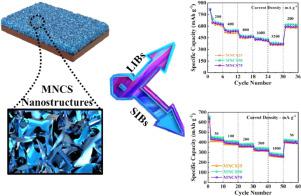Applied Materials Today ( IF 7.2 ) Pub Date : 2020-09-03 , DOI: 10.1016/j.apmt.2020.100807 P. Santhoshkumar , Nitheesha Shaji , Gyu Sang Sim , Murugan Nanthagopal , Jae Woo Park , Chang Woo Lee

|
Rechargeable metal ion batteries have attracted considerable attention in modern society because environmental issues are getting worse over time. They are highly expecting to play a vital role in day-to-day life in portable electronic devices (EVs) as well as hybrid electric vehicles (HEVs). Herein, we report the synthesis of bimetallic dichalcogenide by a solvothermal technique and systematically explore the effect of mesoporous NiCoSe2 (MNCS) nanostructures by controlling the ratio of surface-active agent during the synthesis process. The depth morphological evaluation using high-resolution field-emission transmission electron microscopy (HR FE-TEM) suggests that all the MNCS nanostructures display similar morphology with an extended network of material architecture when the ratio of surface active agent increased and thus interestingly play an important role in enhancement of surface area and porosity of the as-prepared electrode architecture. Interestingly, an obtained MNCS50 nanostructure displays a specific capacity of 557 and 398 mAh g−1 after 100 and 60 cycles for lithium ion batteries (LIBs) and sodium ion batteries (SIBs), respectively. The larger surface area and high porous nature of MNCS50 nanostructure affords more spaces to accommodate larger numbers of lithium (Li) and sodium (Na) ions during the discharge/charge process, and the nanostructured electrode material often enhances the electrical conductivity. These observations are indicating the use of nanostructured anode materials for LIBs and SIBs.
中文翻译:

合理设计的介孔NiCoSe 2纳米结构的轻松和溶剂热合成及其改善的锂和钠存储性能
可充电的金属离子电池在现代社会引起了相当大的关注,因为随着时间的流逝,环境问题变得越来越严重。他们高度希望在便携式电子设备(EV)以及混合动力汽车(HEV)的日常生活中发挥至关重要的作用。在本文中,我们报道了通过溶剂热技术合成双金属二硫化二氢,并系统地探索了介孔NiCoSe 2的作用(MNCS)纳米结构通过控制合成过程中表面活性剂的比例来实现。使用高分辨率场发射透射电子显微镜(HR FE-TEM)进行的深度形态评估表明,当表面活性剂的比例增加时,所有MNCS纳米结构均具有相似的形态,并具有扩展的材料结构网络,因此有趣地发挥了重要作用在提高所制备电极结构的表面积和孔隙率方面发挥了重要作用。有趣的是,获得的MNCS50纳米结构显示的比容量为557和398 mAh g -1分别对锂离子电池(LIB)和钠离子电池(SIB)进行100和60次循环后。MNCS50纳米结构的较大表面积和高多孔性为放电/充电过程中提供了更多空间来容纳更多的锂(Li)和钠(Na)离子,并且纳米结构的电极材料通常会增强电导率。这些观察结果表明纳米结构阳极材料用于LIB和SIB。











































 京公网安备 11010802027423号
京公网安备 11010802027423号